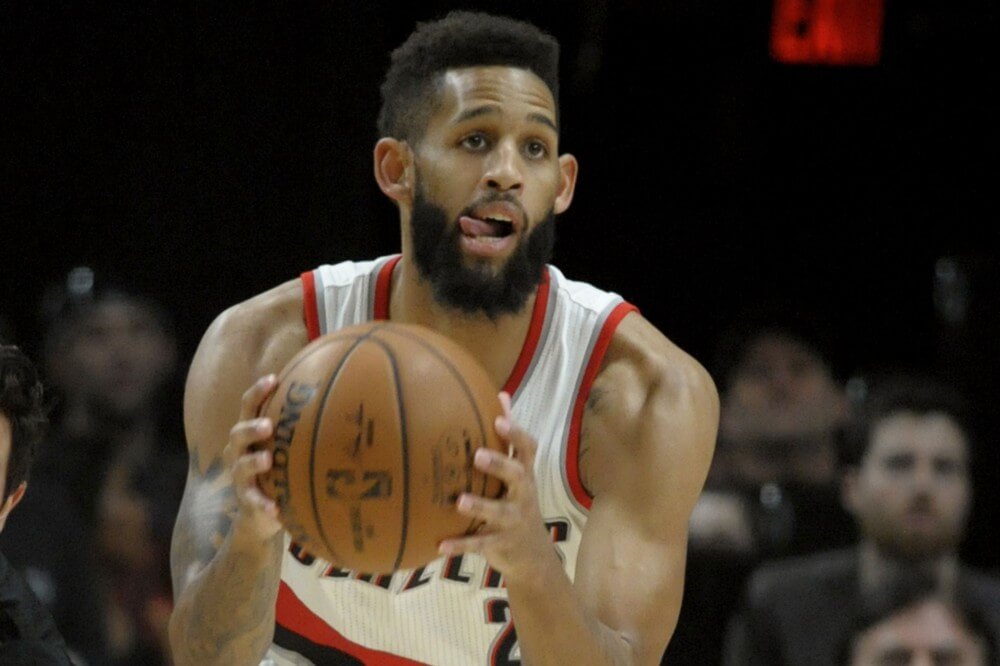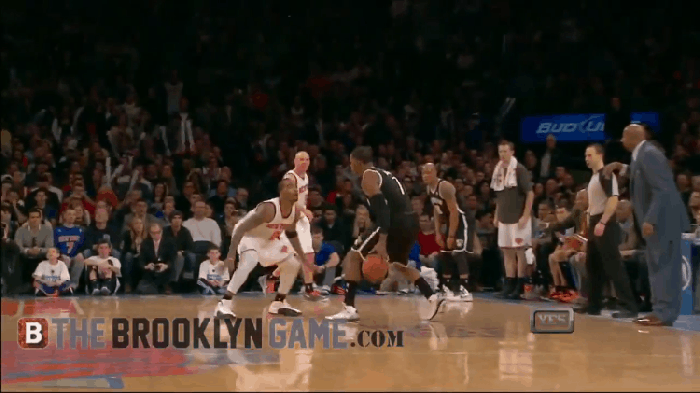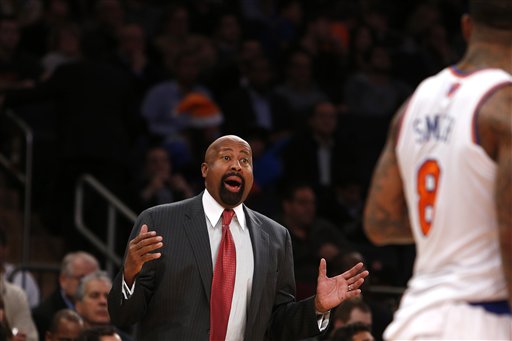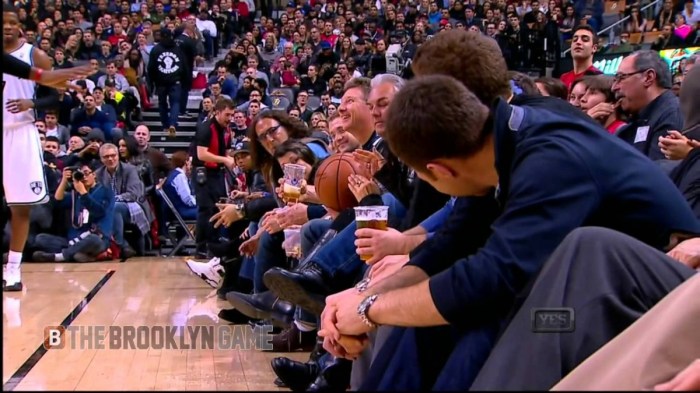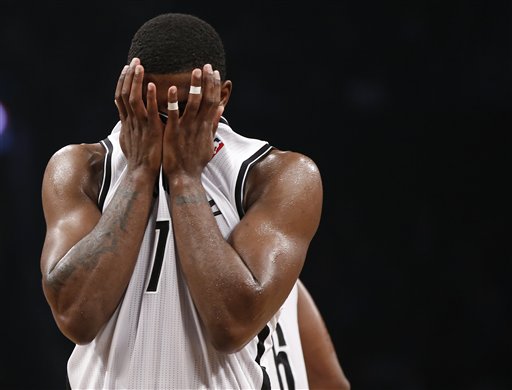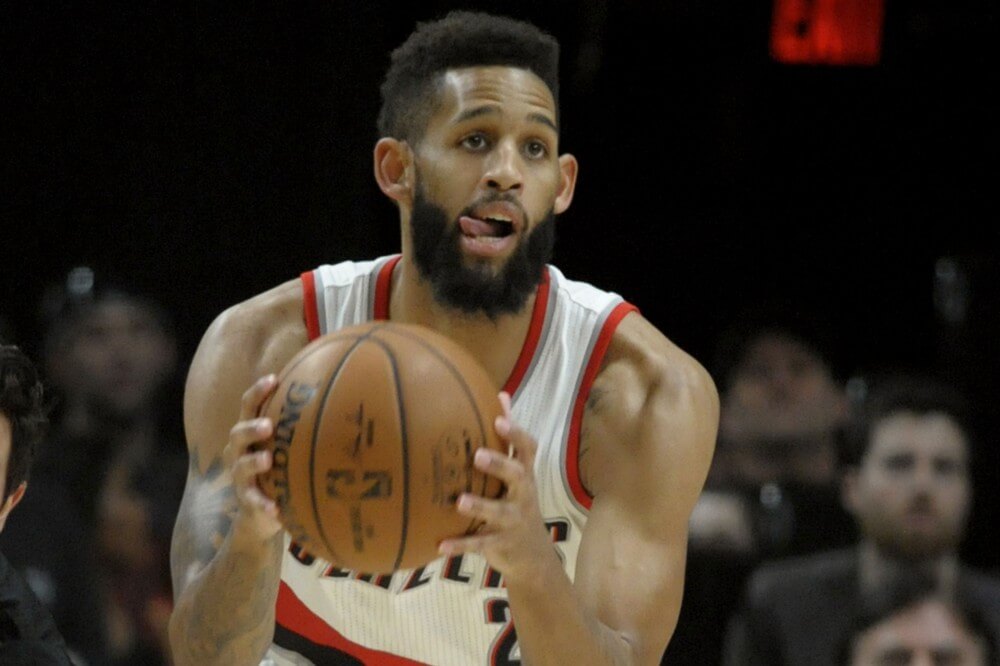
Allen Crabbe, Shooting Guard
2016-17: 28.5 MPG, 10.7 PPG, .468 FG%, 2.9 RPG, 1.2 APG, 0.7 SPG, 0.3 BPG, 0.8 TOV, 79 G
Who is Allen Crabbe?
Like an implacable Liam Neeson after punching his way through Eastern European henchmen, Sean Marks finally got his man.
A year after signing Allen Crabbe to a four-year, $75 million offer sheet in an effort to pry the Cal product away from the Portland Trailblazers in restricted free agency, Marks sent Andrew Nicholson to the Pacific Northwest (however fleetingly) for the four-year Portland wing. It was the final, best part in Marks’ maneuvers that eventually turned Bojan Bogdanovic into Allen Crabbe and the first round pick that became Jarrett Allen, a more impressive work of art than anything currently hanging in the Portland Museum of Contemporary Crafts.
If Marks’ initial move of trying to sign an untested, non-star wing to a $19 million-a-year contract, then his follow-up — getting that same young talented wing player a year later on what’s suddenly a three-year, $56 million contract while giving up nothing of value — was widely heralded as solid and smart… if a bit pricey. But then, for that Marks has got no one to blame but himself.
Still, you can see where Marks’ thinking lies. Crabbe is the prototypical modern NBA wing: a rangy, 6-foot, 6-inch shooter who projects as an offensive-minded scorer who will hopefully grow into a defensive role as he also works on his playmaking abilities. He’s a shooter who struggles to create his own shot… or at least, that’s what it seems like (more on that below).
He was the first pick of the 2014 NBA Draft’s second round by Cleveland and traded on draft night to the Blazers. He spent his first two years in Portland, playing sporadically, but broke out in his third year to average 10.3 points a game on 46 percent shooting (and nearly 40 percent from three). That’s when Marks — hamstrung by the ruinous regime of Billy King and needing ways to find young, undervalued talent — decided to throw that offer sheet his way.
He also has impeccable hair and an easy-going, chilled nature.
(I also spent most of a 2015 Brooklyn Nets-Portland Trailblazers game boozily swearing vociferously at the lackluster effort of the Nets… and was terribly embarrassed after Crabbe’s family church group — seated directly behind me for the entire game — introduced themselves and wanted to know what they thought of the man they were exceptionally, and understandably, proud of. Lovely people, and oddly very understanding of the sweary nature of random Australians in Brooklyn it would seem… But, if nothing else, their immense pride in Crabbe definitely shone through: they couldn’t have been more proud.)
2016-17 Recap
After playing alongside playmakers Damian Lillard and C.J. McCollum in Portland and excelling in his role as a third-string scorer for his first three years, last year Crabbe found himself pushed to the margins with the arrival of Evan Turner (aka The Villain).
The Villain ate into Crabbe’s minutes and took over the role as the second unit’s focal point, which, to be honest, turned out pretty poorly for both players. Turner sat a downturn in effectiveness from his time in Boston, while Crabbe’s growth stymied as he saw his usage rate slip from 16.4 percent in 2015-16 to 14.9 percent in 2016-17, even as his cheques got substantially bigger.
BUT. As mentioned, Crabbe is viewed as a shooter with limited playmaking ability… but context matters. Consider that in Portland last year Crabbe was stuck with 8.3 field goal attempts… while Dame, C.J. and The Villain combined for 46.3 per game. Yeesh.
And… Um. Yeah, this.
https://twitter.com/HPbasketball/status/913440775974694912
Yikes. So. Say Portland doesn’t roll the dice and sign The Villain in free agency, and he spends another year as the clear-cut third option on that Portland team (which, by the way, dropped from the West’s fifth seed to its eighth with Turner’s arrival… just sayin’). Crabbe’s numbers could much more likely have been in line with the growth we’d expect from a third-to-fourth year wing… say, perhaps more like the jump witnessed between Otto Porter’s third and fourth year?
ANYWAY. Crabbe’s statistical categories plateaued across the board, averaging 10.7 points and logging only 2.9 rebounds, 1.2 assists and 0.7 steals per game, all of which were almost exactly in line with his 2015-16 numbers.
Still, Crabbe improved his shooting percentages from his prior campaign —most impressive was his uptick in three-point shooting, going from 35.3 to 44.4 percent, leading to a much better effective field goal percentage for the year in 57.2 percent.
More impressive, however, was his performance in a late-season win against the Minnesota Timberwolves, where he hit eight of 10 three-pointers en route to 26 points….
https://youtu.be/-lUXb7sSo74
…and a particularly nice scoring stretch in January, where he scored 30 (in OT against Detroit), 24 (against Cleveland), 23 (against Memphis) and 21 (against Charlotte). That’s pretty dope for a guy who allegedly can’t create his own shot.
So, what does Crabbe bring to the table?
Beyond great hair and a winning smile, the moment he was traded to the Nets, Crabbe instantly became their best shooter — only the break-in-case-of-emergency Quincy Acy shot better than 40 percent last year, and no one else really came close — and brought desperately needed wing scoring and size.
Dude is a scorer, pure and simple. He possesses a silky smooth jumper and OK court awareness that leads to him curling off screens and scoring on a combination of jumpers and back cuts. His shooting splits show this pretty clearly too: 70 percent of all his made shots were either in the paint or behind the three-point line.
https://youtu.be/XqUuh-nOSFo
The numbers (all via stats.nba.com) also back up how little he was called upon to create his own shot in Portland: a whopping 86.1 percent of his shots were assisted, and 97 percent of his three-pointers were assisted, as Crabbe only hit four non-assisted threes all year. The good part is that Crabbe hit 46.2 percent of his catch-and-shoot threes last year, on top of the 55.7 percent he shot from inside 10 feet from the rim (even if it only came on 1.8 attempts, that’s still around the same mark as DeMar DeRozan and Chris Paul… but also C.J. Miles and, uh, Anthony Morrow).
The other parts of his game — rebounds, assists, steals — all need work, but considering his role in Portland was purely as a scoring shooting guard, it’ll be interesting to see if Crabbe’s full game can blossom when given the opportunity. At the moment, his raw numbers fall in line with other score-first bench guys who do not add much by way of other stats, like J.R. Smith, Will Barton and Lou Williams.
His closer statistical comparisons, though, are more telling. Crabbe is one of five players to average over 10 points per game with fewer than 3 rebounds and 1.5 assists: the other four are J.J. Reddick, Terrence Ross, Wayne ‘Now Resurgent in Miami’ Ellington and, gulp, probable future NBA champion Swaggy P himself, Nick Young.
HOWEVER. Those are all NBA veterans. The hope is that there is plenty of room in his game for growth: his defense needs to improve dramatically for him to be thought of as any kind of stopper (he currently has a brutal defensive box plus/minus of -1.3 per 100 possessions), while his oft-maligned ball-handling is in a constant state of being tightened up. The crucial part will be seeing how effective and efficient he can be when that 14.9 percent usage rate sees an uptick… it might be the difference between Crabbe looking like Terrence Ross, or Otto Porter-lite.
The Bottom Line
The tricky part for this entire Brooklyn Nets season will be figuring out how to spread shots around a team full of not-that-efficient score-first options. Crabbe’s usage rate and shot attempts in Portland suffered from being around primary scorers like Dame, C.J. and The Villain in a system that wasn’t that geared to making his life easier… and with a suddenly deep (if not, y’know, ‘that good’) wing rotation in Brooklyn, and even though he’s easily the most efficient scorer of the bunch, Crabbe could easily once again be marginalized while fighting for attempts with D’Angelo Russell, Jeremy Lin, Caris LeVert, DeMarre Carroll, Sean Kilpatrick, Joe Harris and Rondae Hollis-Jefferson.
He will, however, be the highest paid player on his new team (at $19 million a year). With that comes a level of expectation and respect… and ideally, a recognition by a coaching staff that has a game planned clearly geared towards taking as many threes as possible, that perhaps getting the ball to their best three-point shooter ought to be a priority.
A part of that will also, while being given the opportunity, rely on Crabbe’s dedication to rounding out his game to become the sort of player worth paying $19 million a year. Along with Atkinson and his player development credentials, that appears to be what Marks is relying on.
If it works out and Crabbe comes close to living up to that hefty contract, Marks will look like a genius. If not, well, it’s three years for an overpaid wing… and there are plenty of those to go around.
The Brooklyn Game Player Previews: Quincy Acy, Jarrett Allen, Trevor Booker, DeMarre Carroll

